This is our seventh weekly instalment of interviews with teachers in Project “Our School” who we have described as i-Teachers, inclusion teachers, who work day in and day out to make sure that no one is left behind [see news: Our School].
Today, a short video and an interview by Ilaria Gaudiello will introduce us to Silvia Giordano, a first-degree secondary school professor of mathematics and science, digital coordinator, and certified Google Trainer.
 Silvia Giordano is a first-degree secondary school professor of mathematics, but she has also worked as a support teacher in second-degree schools. As a digital coordinator and certified Google Trainer, she works on her passion for new technology and digital didactics, developing new teaching practices to capture her students’ attention. She believes education is an exchange of knowledge, a bidirectional sharing process. Together with her group, she has worked on a course based on an imaginary voyage to a modern-style Flatland. The journey begins with a geometry based on experience, an “intuitive geometry” that overturns geometrical canons by starting out with axiomatic geometry and then addresses 3D solids.
Silvia Giordano is a first-degree secondary school professor of mathematics, but she has also worked as a support teacher in second-degree schools. As a digital coordinator and certified Google Trainer, she works on her passion for new technology and digital didactics, developing new teaching practices to capture her students’ attention. She believes education is an exchange of knowledge, a bidirectional sharing process. Together with her group, she has worked on a course based on an imaginary voyage to a modern-style Flatland. The journey begins with a geometry based on experience, an “intuitive geometry” that overturns geometrical canons by starting out with axiomatic geometry and then addresses 3D solids.

INTERVIEW
Silvia, the “Our School” Call has allowed the Fondazione Mondo Digitale to identify you as an experimenting teacher. You have recently worked with your students on the production of a short video with digital AV tools, contests with instant polling tools and a digital helpdesk. What impact have you observed in your classes? What is the degree of active participation? What do your students teach you?
Students are always very attracted and fascinated by digital tools. They react positively, with enthusiasm, and contribute actively. Exalting their role in a project helps to involve them and increase their feeling of responsibility. And this is also true of students who often don’t participate. You can always learn something from students, especially when it comes to digital tools, and without any judgement on their part.
The “Our School” group with which you have been collaborating is developing an innovative geometry course that will soon be published. As you know, at the Fondazione Mondo Digitale we never believe that is innovation is only pedagogic or only digital, but it is also, in a wider sense, civic. Do you believe that this unit will be useful for teaching Civic Education?
This geometry course aims to identify the relation between what we study in books and what we experience in everyday life, thanks to the use of tools that have become pervasive, like Google Maps, for example. One of the priorities of digital civic education is to give students the tools to bring together the digital and daily tangible dimensions, as well as to understand that we are real in both dimensions. Today, students are constantly connected and the boundaries between life on-line and that at school, at home, or outside are not well-defined. However, pedagogically speaking, this can be an advantage, if the tools are used for didactic objectives.
The FMD’s “Our School” bases collaboration on a constant exchange aiming to achieve perfection in learning design methods and address the educational priorities of our complex age. If you were to imagine working with your group for another year, what do you believe would be crucial to focus on for the development of new content and the future evolution of the programme?
I believe that we should never lose sight of our students and their world, their needs, their issues and their reality. Moreover, in the educational field, we must always remember everyone. I believe that it is essential to employ digital tools to improve any type of difficulty, disability or issue and give everyone the same educational opportunities.



